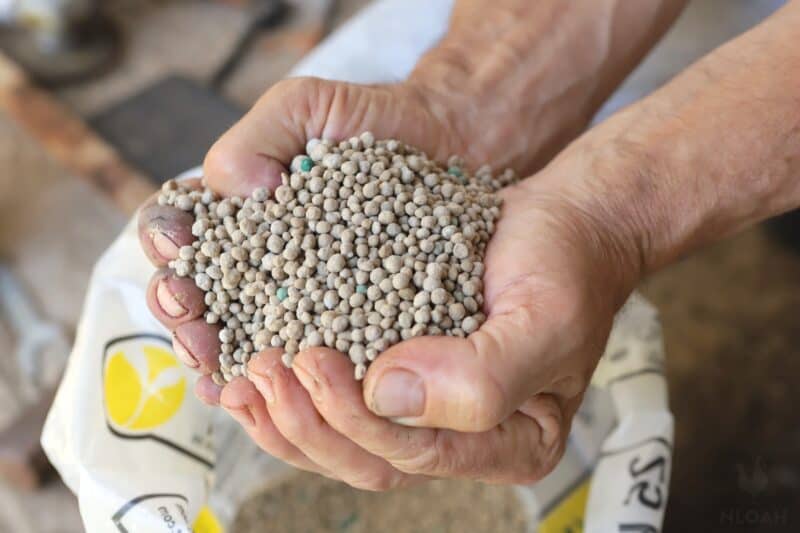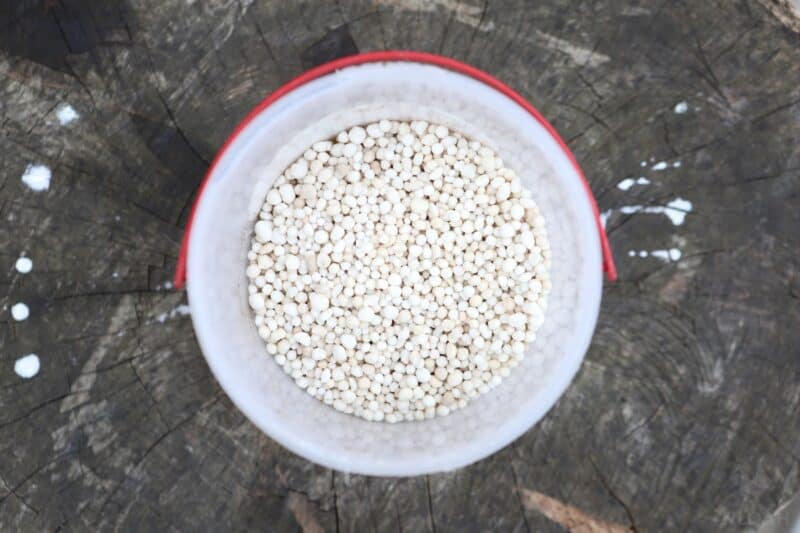Gardening is a popular hobby, and it’s also a great way to improve your self-sufficiency and your connection with the food you eat.

But it is a lot harder than most people think, especially when ti comes to feeding your plants over time.
Without the right nutrients, your plants won’t thrive and they may fail to bloom or fruit entirely!
That’s why fertilizer is your not-so-secret weapon for helping your plants grow big and stay healthy. But what is NPK fertilizer, and what do those letters stand for?
The NPK on fertilizers stands for Nitrogen (N), Phosphorus (P), and Potassium (K). These are the three essential macronutrients needed by plants to grow, develop, and produce fruits or flowers. NPK fertilizers have a blend of these three elements in varying amounts.
It sounds uncomfortably close to chemistry class for some of us (and it is!) but I promise that understanding fertilizer theory is really quite easy.
Learning how each nutrient helps to fuel plant growth is critical to selecting the right NPK fertilizers for your garden, so you’ll need to crack the code before you get too far down the line in your own garden.
In this article, I’ll tell you all about the vital trio of fertilizer nutrients that fuel your plants’ growth. Grab your gloves and let’s go.
What Does the NPK Stand for in Fertilizer?
The NPK you see referenced on a bag of fertilizer, or in conversation referencing it, refers to the three nutrients: Nitrogen (N), Phosphorus (P) and Potassium (K).
These are the three macronutrients that plants need in varying quantities to support growth.
Each of these elements plays a key role in helping pretty much all plants grow, so you will always see some combination of them on most fertilizers- though not always!
Different species of plants will need different amounts of each nutrient, and some will need more or less at different phases of growth or in different seasons.
For this reason, understanding the needs of your plants and the specific combination of NPK in the fertilizer you are using is vital to choosing the right one.
What Do The Numbers On NPK Fertilizer Mean?
The numbers you invariably see on a given fertilizer package refer to the percentage (by weight) of each nutrient present in the product. Usually expressed as X-X-X, where ‘X’ may be a two- or single-digit number.
For example, a 12-6-4 fertilizer contains 12% nitrogen (N), 6% phosphorus (P), and 4% potassium (K).
It’s important to note that this does NOT mean that there are only these three elements present in the fertilizer; there may be other trace elements or additives present as well.
It also does not tell you anything about the form of the nutrients: are they water-soluble? Slow-release? How are they best used to feed your plants?
For this sort of info you must consult the spec sheet, if the product has one. Be sure to also always check the full ingredients list on any product you buy so you know exactly what you and your plants are getting.
What Does the Nitrogen (N) in Fertilizer Do for Plants?
Nitrogen (N) is one of the most important nutrients for plant growth and development, making it a crucial component in fertilizers.
Nitrogen is the essential building block of plant cells, proteins, and enzymes. It’s also a component of chlorophyll, the pigment that gives plants their green color and allows them to carry out photosynthesis.
When your plants receive enough nitrogen, they can produce healthy leaves and stems, as well as strong roots.
Nitrogen is particularly important during the vegetative growth stage of plants when they’re actively growing leaves and stems. Without enough nitrogen, plants may appear stunted, yellow, or brown, and their growth may slow down.
However, too much nitrogen can be harmful or deadly to your plants- and the environment!
Excessive use of nitrogen fertilizers can lead to nutrient imbalances, leaching of excess nitrogen into water sources, and soil acidification. All bad things.
It can also contribute to air pollution, as excess nitrogen can be released into the atmosphere in the form of greenhouse gases.
Nitrogen is a critical nutrient for plant growth and development, but one that you must apply in moderation for optimal plant growth and environmental health.

What Does the Phosphorus (P) in Fertilizers Do for Plants?
Phosphorus (P) is another vital nutrient that all plants need in varying amounts. It plays a vital role in many plant physiological processes, including photosynthesis, energy storage and transfer, and cell division. Phosphorus is also needed for root growth, seedling development, and crop maturity.
Without enough phosphorus, plants may have weak and shallow roots, which can make them more susceptible to drought, heat, and other environmental stresses.
But when plants receive adequate phosphorus, they’re far more likely to produce healthy flowers and fruits.
Getting adequate phosphorus to plants is particularly important during the early stages of plant growth when plants are developing their root systems.
For fruits and veggies, phosphorous is what can increase the size and weight of fruits, improve color and flavor, and enhance their nutritional value overall. Critical for gardeners!
However, although its impact is not as significant as nitrogen above, too much phosphorus can likewise be harmful to plants and again to the surrounding environment.
Excessive use of phosphorus fertilizers can contribute to the accumulation of heavy metals in soil and water, which can harm people, plants and animals!
What Does the Potassium (K) in Fertilizers Do for Plants?
Don’t get confused on this one: the ‘K’ on the ratio is for potassium not because P was already taken. It is because K is the periodic symbol for potassium!
Anyways, Potassium (K) serves a critical role in many physiological processes, most importantly water regulation.
But it is also crucial for a plant’s stress tolerance, enzyme activation, and photosynthesis. Potassium is what helps out with overall growth, fruit ripening, and disease resistance.
Potassium is a resource you need to get to plants when they are struggling, especially with heat.
This is because it helps plants to maintain turgor pressure, which is necessary for supporting their structure and transporting the other nutrients and water throughout the plant.
In this way, potassium also helps plants to tolerate drought and other environmental stresses, such as high temperatures and salinity.
Furthermore, potassium is likewise beneficial for your fruits and veggies because it is necessary for the formation of sugars and starches, which contribute to the sweetness and texture of fruits.
What Other Ingredients Might be in NPK Fertilizers?
While nitrogen, phosphorus, and potassium are the primary macronutrients found in fertilizers, there are many other ingredients that may also be included.
One common ingredient found in fertilizers is calcium (Ca), which can contribute to better plant growth and disease resistance.
Calcium is also necessary for soil structure, helping to improve soil water-holding capacity and reduce soil compaction. Magnesium (Mg) is another essential nutrient that can be found in fertilizers. Sulfur (S) yet another common nutrient.
In addition to these primary nutrients, fertilizers may also have micronutrients or secondary nutrients like iron (Fe), manganese (Mn), and zinc (Zn). These are required by plants in truly small amounts but are still essential for their growth and development.
Other ingredients found in fertilizers include soil conditioners like humic acid and compost.
These ingredients together can improve soil structure, increase water retention and nutrient availability, and support beneficial soil microbes.
Additionally, fertilizers may contain additives like wetting agents and foliar feeds, which can improve fertilizer absorption and further enhance plant growth.
Various Types of NPK Fertilizers
There are many, many, many kinds of fertilizers out on the market, both as name-brand blends and generic offerings.
Learning your way around them will help you be better prepared to take care of all kinds of plants, no matter your soil conditions. The following are some of the most common:
- 8-8-8 AKA Triple-8. A great all-around fertilizer.
- 16-4-8 “High Nitro”. Excellent for grasses and leafy vegetables.
- 0-0-60 Pretty much straight potassium. When you need heat and drought protection, reach for this.
- 15-0-15 Special use fertilizer when soil phosphorous levels are too high already.
- 17-17-17 Potent all-purpose fertilizer.
- 15-15-15 Another strong all-purpose fertilizer.
- 19-19-19 One of the strongest general purpose fertilizers in common use.
- 0-20-20 For situations when plants need lots of phosphorous and potassium, but soil nitro levels are already too high, or when nitro is not called for.
- 6-24-24 A little nitrogen to promote greenery, but a big boost of P and K to help fruits and veggies getting close to ripening.
- 30-0-10 A great lawn fertilizer. Lots of nitrogen for healthy, green grass and plenty of potassium to protect from summer heat and drought conditions.
- 30-0-4 makes a fairly good pre-planting fertilizer
Tom has lived and worked on farms and homesteads from the Carolinas to Kentucky and beyond. He is passionate about helping people prepare for tough times by embracing lifestyles of self-sufficiency.
